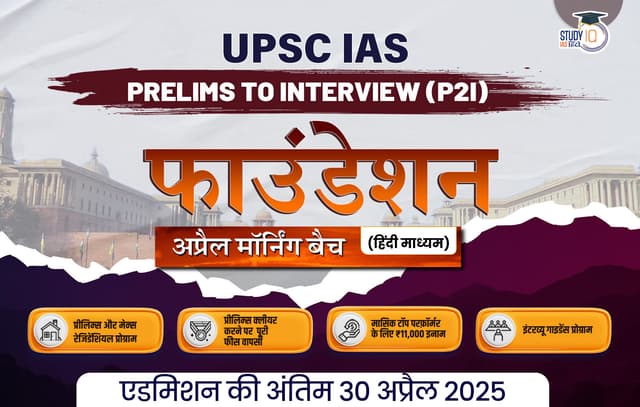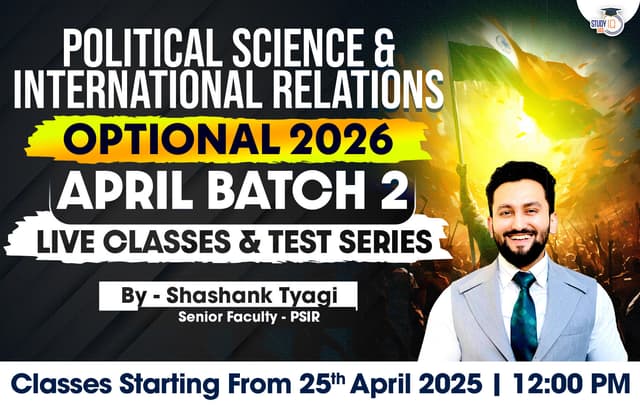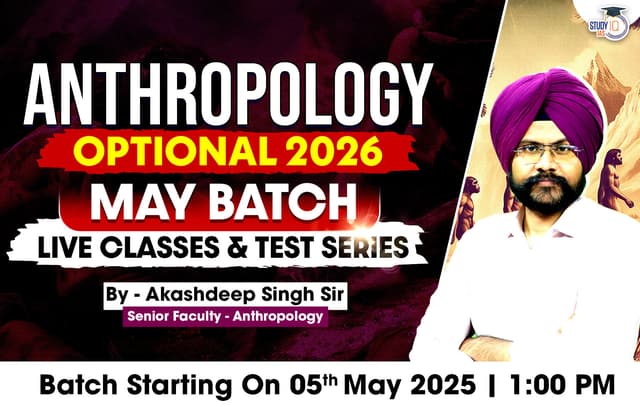Daily Quiz 23 January 2025
Quiz-summary
0 of 5 questions completed
Questions:
- 1
- 2
- 3
- 4
- 5
Information
- Click on – ‘Start Quiz’ button
- Solve Questions
- Click on ‘Next’ button
- Click on ‘Finish Quiz’ button
- Now click on ‘View Questions’ button – here you will see solutions and links.
- The test contains a total of 5 questions.
- Click on the most appropriate option to mark it as your answer.
- You will be awarded Two marks for each correct answer.
- You can change your answer by clicking on some other option.
- A Number list of all questions appears at the top side of the screen.
- You can access the questions in any order by clicking on the question number given on the number list.
- You can use rough sheets while taking the test.
- Do not use calculators, log tables, dictionaries, or any other printed/online reference material during the test.
- Do not click the button “Finish Quiz” before completing the test. A test once submitted cannot be resumed.
You have already completed the quiz before. Hence you can not start it again.
Quiz is loading...
You must sign in or sign up to start the quiz.
You have to finish following quiz, to start this quiz:
- 1
- 2
- 3
- 4
- 5
- Answered
- Review
-
Question 1 of 5
1. Question
1 pointsConsider the following statements:
1. Battle of Longewala was one of the major engagements in the Indo-Pakistani War of 1971.
2. Under the”OperationMeghdoot”, the Indian Army established its full control over the siachen glacier.
Which of the statements given above is/are correct?Correct
Answer: C
Explanation:
• Statement 1 is correct: The Battle of Longewala (47 December 1971) was one of the first major engagements in the Indo-Pakistani War of 1971. It was fought between invading Pakistani forces and Indian defenders at the Indian border post of Longewala, in the Thar Desert of Rajasthan.
o The Longewala battle saw 120 Indian soldiers prevent the advance of2,0003,000 Pakistani soldiers, who were aided by around 40 tanks. Even the Indian Air Force played a crucial role as itsHawker Hunters and HAL Marut fighter-bombers destroyed the entire Pakistani tank platoon.
• Statement 2 is correct: The Siachen glacier at the height of around 20,000 feet in the Karakoram mountain range is known as the highest militarised zone in the world where soldiers have to battle frostbite and high winds, Under its “Operation Meghdoot”, the Indian Army established its full control over the glacier on April 13, 1984.Incorrect
Answer: C
Explanation:
• Statement 1 is correct: The Battle of Longewala (47 December 1971) was one of the first major engagements in the Indo-Pakistani War of 1971. It was fought between invading Pakistani forces and Indian defenders at the Indian border post of Longewala, in the Thar Desert of Rajasthan.
o The Longewala battle saw 120 Indian soldiers prevent the advance of2,0003,000 Pakistani soldiers, who were aided by around 40 tanks. Even the Indian Air Force played a crucial role as itsHawker Hunters and HAL Marut fighter-bombers destroyed the entire Pakistani tank platoon.
• Statement 2 is correct: The Siachen glacier at the height of around 20,000 feet in the Karakoram mountain range is known as the highest militarised zone in the world where soldiers have to battle frostbite and high winds, Under its “Operation Meghdoot”, the Indian Army established its full control over the glacier on April 13, 1984. -
Question 2 of 5
2. Question
1 pointsConsider the following statements:
Statement-I:
Earthquake early warning systems don’t predict earthquakes.
Statement-II:
Earthquake early warning systems detect ground motion as soon as an earthquake begins.
Which one of the following is correct in respect of the above statements?
Correct
Answer: A
Explanation:
- Both Statement-I and Statement-II are correct and Statement-II is the correct explanation for Statement-I: Earthquake early warning systems don’t predict earthquakes. Instead, they detect ground motion as soon as an earthquake begins and quickly send alerts that a tremor is on its way, giving people crucial seconds to prepare.
- Such systems, including ShakeAlert on the West Coast of the United States, operate on the principle that while seismic waves travel at just a few miles per second, electronic alerts from the region of the epicenter can be sent almost instantly. Here’s how it works:
- During an earthquake, several types of seismic waves radiate out from the quake’s epicenter. First, weaker but faster-moving P-waves trigger sensors that, in turn, transmit signals to data processing centers.
- Algorithms quickly estimate the earthquake’s location, magnitude, and intensity: Where is it? How big is it? Who is going to feel it?
The system then sends an alert before slower, but more destructive S-waves and surface waves arrive.
Incorrect
Answer: A
Explanation:
- Both Statement-I and Statement-II are correct and Statement-II is the correct explanation for Statement-I: Earthquake early warning systems don’t predict earthquakes. Instead, they detect ground motion as soon as an earthquake begins and quickly send alerts that a tremor is on its way, giving people crucial seconds to prepare.
- Such systems, including ShakeAlert on the West Coast of the United States, operate on the principle that while seismic waves travel at just a few miles per second, electronic alerts from the region of the epicenter can be sent almost instantly. Here’s how it works:
- During an earthquake, several types of seismic waves radiate out from the quake’s epicenter. First, weaker but faster-moving P-waves trigger sensors that, in turn, transmit signals to data processing centers.
- Algorithms quickly estimate the earthquake’s location, magnitude, and intensity: Where is it? How big is it? Who is going to feel it?
The system then sends an alert before slower, but more destructive S-waves and surface waves arrive.
-
Question 3 of 5
3. Question
1 pointsConsider the following statements:
- India is the world’s largest consumer of crude oil.
- India depends on imports to meet more than 85% of its crude oil requirement.
- In 2024, Russian oil accounted for nearly more than fifty percent of India’s total oil imports.
How many of the above statements are correct?
Correct
Answer: A
Explanation:
- Statement 1 is not correct and statement 2 is correct: India, the world’s third-largest consumer of crude oil, depends on imports to meet more than 85% of its requirement.
Statement 3 is not correct: Russia was a marginal supplier to India before the war in Ukraine; it is now India’s biggest supplier of crude, after Moscow began to offer significant discounts to offset the impact of the West shunning its oil. In 2024, Russian oil accounted for nearly 38% of India’s total oil imports, according to tanker data.
Incorrect
Answer: A
Explanation:
- Statement 1 is not correct and statement 2 is correct: India, the world’s third-largest consumer of crude oil, depends on imports to meet more than 85% of its requirement.
Statement 3 is not correct: Russia was a marginal supplier to India before the war in Ukraine; it is now India’s biggest supplier of crude, after Moscow began to offer significant discounts to offset the impact of the West shunning its oil. In 2024, Russian oil accounted for nearly 38% of India’s total oil imports, according to tanker data.
-
Question 4 of 5
4. Question
1 pointsWhich one of the following groups of states in India represent the top three states in terms of industrial production?
Correct
Answer: A
Explanation:
- Option A is correct: Gujarat, Maharashtra and Tamil Nadu are the top three states in terms of industrial production, contributing 13.3 per cent, 13 per cent, and 10.5 per cent, respectively, to India’s total industrial output of $605 billion in 2023.
Incorrect
Answer: A
Explanation:
- Option A is correct: Gujarat, Maharashtra and Tamil Nadu are the top three states in terms of industrial production, contributing 13.3 per cent, 13 per cent, and 10.5 per cent, respectively, to India’s total industrial output of $605 billion in 2023.
-
Question 5 of 5
5. Question
1 pointsConsider the following statements with reference to the festival of Makar Sankranti:
- It marks the Sun changing directions and shifting its trajectory towards the southern direction.
- Unlike most festivals that follow the lunar cycle, Makar Sankranti follows the solar cycle.
Which of the statements given above is/are correct?
Correct
Answer: B
Explanation:
- Statement 1 is not correct: Makar Sankranti or Pongal is a marker for a change of season – warmer months are close and we are moving away from winter, which is seen as a period of inactivity in many ways. It is said that the northward journey of the sun (Uttarayan) begins on this day. In the Hindu belief system, the end of January heralds the beginning of longer days. It marks the Sun changing directions and shifting its trajectory towards the north, therefore, entering the Makara or Capricorn zodiac sign.
- Statement 2 is correct: Unlike most festivals that follow the lunar cycle, Makar Sankranti follows the solar cycle and thus, is celebrated almost on the same day every year. Sankranti is worshipped as a God, who legends believe killed the devil Sankarasur.
Incorrect
Answer: B
Explanation:
- Statement 1 is not correct: Makar Sankranti or Pongal is a marker for a change of season – warmer months are close and we are moving away from winter, which is seen as a period of inactivity in many ways. It is said that the northward journey of the sun (Uttarayan) begins on this day. In the Hindu belief system, the end of January heralds the beginning of longer days. It marks the Sun changing directions and shifting its trajectory towards the north, therefore, entering the Makara or Capricorn zodiac sign.
- Statement 2 is correct: Unlike most festivals that follow the lunar cycle, Makar Sankranti follows the solar cycle and thus, is celebrated almost on the same day every year. Sankranti is worshipped as a God, who legends believe killed the devil Sankarasur.
Results
0 of 5 questions answered correctly
Your time:
Time has elapsed
You have reached 0 of 0 points, (0)
| Average score |
|
| Your score |
|
Categories
- Not categorized 0%
| Pos. | Name | Entered on | Points | Result |
|---|---|---|---|---|
| Table is loading | ||||
| No data available | ||||
Sharing is caring!

 Daily Quiz 26 April 2025
Daily Quiz 26 April 2025





















